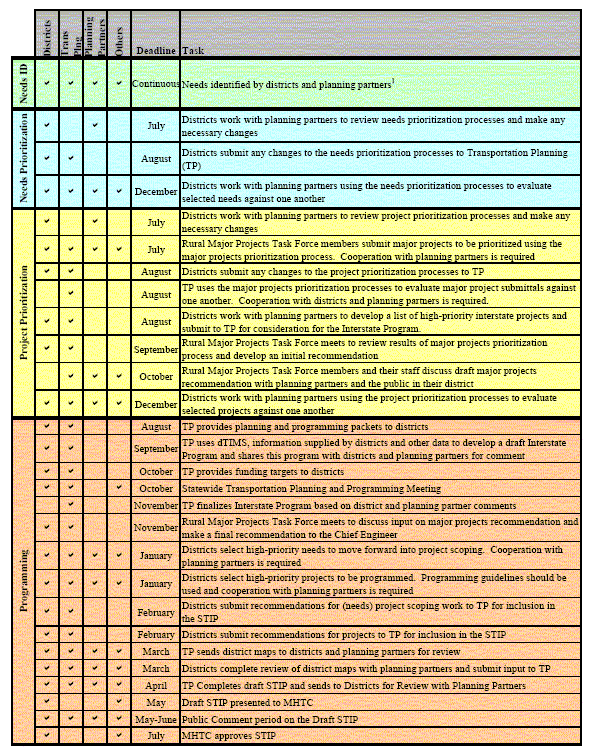121.3 The Statewide Transportation Improvement Program (STIP)
The STIP includes committed construction projects MoDOT awards over a five-year period. The STIP is a rolling construction plan; as one year is completed, another year is added. The STIP is fiscally constrained both over the projected revenue over its life and by each fiscal year. MoDOT districts, MPOs, RPCs and the MPO and RPC boards of directors determine which high-priority projects should be funded.
The yearlong involvement of planning partners, which includes MPOs and RPCs, public officials, special interest groups and citizens, culminates in a 45-day public comment period for the draft STIP. The document is publicized and distributed to locations where Missourians can review it and offer comments. Changes are made in response to comments before a final draft is developed and presented to the Missouri Highways and Transportation Commission for approval.
MoDOT, in accordance with state and federal law, annually prepares the STIP. The STIP includes all projects proposed for funding utilizing existing federal programs and state general revenue. The STIP sets forth the specific highway, bridge, transit, aviation, rail, waterway, enhancement and other construction projects MoDOT is going to complete during a five-year period. It provides accountability to taxpayers for the tax dollars spent.
Except for “preliminary engineering only” projects, STIP projects are commitments to the public that the described project will be delivered within the STIP time frame and budget. However, this commitment is limited to the category of funds included in the STIP. For example, a project that only has right of way funds does not indicate a commitment to construct the project, only that the right of way will be obtained in that time frame. MoDOT’s accountability to the public is measured by its ability to deliver the described project within the right of way and construction dollars included in the STIP as well as the planned fiscal year for the activities.
Once a transportation need has progressed through the needs prioritization process, the scoping process and the project prioritization process, the solution and associated project should be so well defined that accurate costs and project delivery schedules can be forecast. Only projects that have been developed to this level of detail should include commitments of right of way or construction funds in the STIP. The District Engineer must approve a project via SIMS or by a positive response to an automated email from SIMS for any project to be added to the right of way or construction component of the STIP. Transportation Planning Division must concur with the District Engineer-approved major projects or projects funded with statewide funds prior to the inclusion of any right of way or construction funds in the STIP.
MoDOT is required by law to produce a STIP that accounts for all of the funding to be spent by MoDOT over the given time frame. This requirement, together with public expectations, will not allow MoDOT to produce a STIP that only includes right of way and/or construction funds for a few projects while including preliminary engineering funds only for the remainder. MoDOT does not have the option to scope projects through four years of the STIP and include right of way and construction funds for projects in only the current year. The first three years of the STIP should be fully programmed with specific projects.
This does not rule out the possibility that some projects may require the programming of preliminary engineering funds only in the STIP for multiple years in order to allow the scoping process to be completed. Preliminary engineering funds should be included in the STIP prior to the first year that a project specific commitment of right of way and/or construction funds is required to be included. There must be a balance between the desire to produce the most accurate estimates possible and the requirements for producing the STIP.
For most projects, the minimum level of project development necessary to accurately identify the costs and delivery schedule occurs at the preliminary plans stage. For some projects this minimum level of project development will be adequate to accurately predict right of way costs, construction costs and delivery schedule. Other more complex projects may require a greater level of development to achieve the desired level of accuracy.
Preliminary plan quantities and historic unit cost data are used to produce the STIP construction cost estimate. Refer to 104.7 Estimates for additional information. Right of way estimates will be based on the tentative right of way lines identified in the preliminary plans and preliminary estimates of individual property values. At this point in the project development process any unusual conditions or costly items, such as major utility adjustments, how traffic will be handled during construction, any special working restrictions that may be placed on the contractor, incentive/disincentive clauses, contract acceleration clauses, environmental constraints, environmental mitigation commitments, etc., should also be identified and included in the project’s estimate.
These estimates are then used to provide the initial costs that are included in the STIP. Adjustments for inflation are included on an annual basis and costs included in the STIP are updated as the design of the project progresses.

